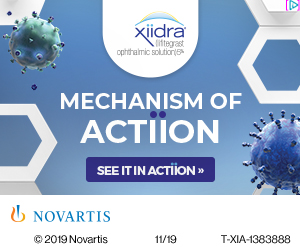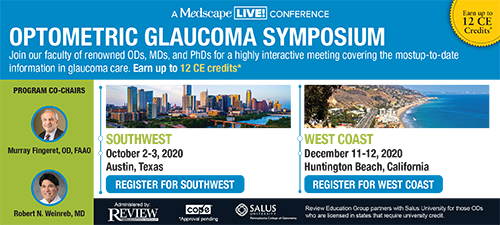
A
weekly e-journal by Art Epstein, OD, FAAO
Off the Cuff: Have We Seen the Worst of COVID?
As the lights go back on in many practices throughout the US, most of us still have more questions than answers. COVID-19 has proven to be a formidable foe, especially for a miniscule dot of RNA that has no logical reason to even exist. Despite its seeming worthlessness, it has somehow managed to turn the entire world upside down. Five months after the outbreak began, we still know very little about COVID-19, why it kills some people while others remain asymptomatic. We don’t have an effective treatment or a vaccine. We don’t know how long it will last, if it will disappear or persist, if it will mutate into a more virulent form, or even if the once-infected are immune from becoming infected again. Beyond the raw tragedy that we read about constantly and the understandable panic that some of us feel, coronavirus has caused massive uncertainty for all of us. Not only has it stymied the world’s most brilliant infectious disease minds, in many ways, the ramifications of the disease may yet be far more catastrophic than the actual disease. The COVID outbreak will likely be an inflection point in human history, equally unprecedented by how it has been politicized, sensationalized and even manipulated by the media, as by the death and despair left in its wake. We finally figured out that it is a highly contagious, primarily airborne infection. It is one of a very few diseases that can turn a person into an unwitting deadly weapon aimed at those they are closest to. Yet, wearing a surgical mask or a homemade mask (why aren’t more surgical masks being made available to the public) has become an uncrossable line in the sand for many. Some have asked if COVID is the beginning of the end of the world. It’s hard to argue that it isn’t. Our economy is in free fall, with the worst recession since World War II forecast, because the country has been broadly shut down. Does anyone really know if, in the end, that was the right way to handle the outbreak? Would a more restrained approach have been a better choice? Experts now point to Sweden, which has maintained relaxed standards albeit with much higher infection and death rates than its neighbors, predicting that as the other countries end their restrictions the infection and death rates will equalize. The problem is we don’t really know.Arizona ended its stay-at-home orders on May 15th as the infection and death rate have continued to rise. While I am not a COVID-is-no-worse-than-influenza conspiracy theorist, current data shows the COVID death rate in Arizona as 8.68 in 100,000. In contrast, the most recent CDC data (2018) for influenza/pneumonia death rates in Arizona was 12.4 in 100,000. While the two can’t be compared for more reasons than I have room to explain, once the headlines fade, is COVID something we will eventually learn to live with? Regardless, we have to get back to work, but right now that seems like diving into a dark and murky great unknown. PPE on. The smell of sani wipes in the air. I wish us all luck. I hope we won’t need it.
|
|||||
 |
||
| Exploring the Occurrence Mechanisms of Acute Primary Angle Closure by Comparative Analysis of Ultrasound Biomicroscopic Data of the Attack and Fellow Eyes | ||||
This study explored the anatomical characteristics and occurrence mechanisms of acute primary angle closure (APAC) by comparing the quantitative data of ultrasound biomicroscopic data (UBM) images of the APAC and fellow eyes. A total of 131 patients (262 eyes) were studied over five years by retrospective analysis. The quantitative data from UBM images including angle opening distance at 500 μm (AOD500), trabecular-iris angle (TIA), iris convexity (IC), iris span (IS), iris-lens angle (ILA), iris-lens contact distance (ILCD), iris-ciliary process angle (ICPA) and limbus-ciliary body angle (LCBA) were retrospectively recorded; comparative analysis of the APAC and fellow eyes was performed. The superior, inferior, nasal, temporal and mean AOD500, TIA, IC and LCBA were significantly smaller in APAC than in fellow eyes. Values of the lens thickness (LT), lens/axial length factor (LAF), lens position (LP) and relative lens position (RLP) were lower in APAC than in fellow eyes. In APAC eyes, AOD500 was significantly positively correlated with IC, ILCD and LCBA; TIA was significantly positively correlated with IC, ILCD and LCBA. In fellow eyes, AOD500 was significantly negatively correlated with ILA, and significantly positively correlated with ILCD, ICPA, LCBA, axial length (AL), central anterior chamber depth (CACD) and LP; TIA was significantly negatively correlated with ILA, and significantly positively correlated with IS, ILCD, ICPA, LCBA, AL, CACD, LP and RLP. |
||||
SOURCE: Wang F, Wang D, Wang L. Exploring the occurrence mechanisms of acute primary angle closure by comparative analysis of ultrasound biomicroscopic data of the attack and fellow eyes. Biomed Res Int. 2020;2020:8487907. |
||||
 |
||
| Prevalence and Risk Factors of Dry Eye in 79,866 Participants of the Population-based Lifelines Cohort Study in the Netherlands | ||||
To investigate the prevalence of dry eye among all adult age categories and to discover independent risk factors by investigating a wide range of etiological categories, a cross-sectional association study was conducted, including 79,866 voluntary participants, ages 20 to 94 years, from the population-based Lifelines Cohort Study in the Netherlands. Overall, 9.1% of participants had dry eye disease as measured by the Women's Health Study dry eye questionnaire. Dry eye symptoms were particularly prevalent in 20 to 30-year-old individuals. Dry eye was associated with comorbidities in almost all body systems, including musculoskeletal, gastrointestinal, ophthalmic, autoimmune, psychiatric, pain, functional, dermatological and atopic disorders. Numerous independent risk factors were discovered or confirmed, with strong associations for female sex, contact lens use, irritable bowel syndrome, fibromyalgia, chronic fatigue syndrome, eye surgery including cataract and laser refractive, keratoconus, osteoarthritis, connective tissue diseases, atherosclerosis, Graves' disease, autistic disorder, depression, “burnout,” Crohn's disease, sarcoid, lichen planus, rosacea, liver cirrhosis, sleep apnea, sinusitis, thyroid function and air pollution (NO2). High blood pressure and high BMI were strongly associated with less dry eye, as was current smoking, while ex-smokers had more dry eye. No clear link between dry eye, and lipid or blood glucose levels was found. This study on dry eye confirmed but also refuted many risk factors from smaller epidemiological studies, and discovered numerous new risk factors in multiple etiological categories. Researchers concluded that the finding that dry eye symptoms are particularly common in young adults is concerning and warrants further study. |
||||
SOURCE: Vehof J, Snieder H, Jansonius N, et al. Prevalence and risk factors of dry eye in 79,866 participants of the population-based Lifelines cohort study in the Netherlands. Ocul Surf. 2020; May 3. [Epub ahead of print]. |
||||
| Impact of Contact Lens Wear on Epithelial Alterations in Keratoconus | ||||
The purpose of this study was to characterize the central epithelial thickness (CET) of penetrating keratoplasty corneal specimens obtained from patients with keratoconus (KC) and correlate the histological patterns with their clinical history. Ex vivo histological imaging was performed to measure CET and total corneal thickness (TCT) in 56 patients with KC. Microscopic slides from penetrating keratoplasty corneal specimens, stained with hematoxylin and eosin, were evaluated using brightfield microscopy. CET and TCT were measured, and morphological features were studied. Clinical history regarding duration of KC prior to surgery, and length of and tolerance to contact lens wear were compared and analyzed. |
||||
SOURCE: Sorbara L, Lopez JCL, Gorbet M, et al. Impact of contact lens wear on epithelial alterations in keratoconus. J Optom. 2020; May 3. [Epub ahead of print]. |
||||
| News & Notes | ||||||||
| Quidel Receives Emergency Authorization for Rapid Antigen COVID-19 Diagnostic Assay Quidel received FDA Emergency Use Authorization to market its Sofia 2 SARS Antigen FIA, a rapid point-of-care test to be used with the Sofia 2 Fluorescent Immunoassay Analyzer for rapid detection of SARS-CoV-2 in nasal or nasopharyngeal specimens from individuals meeting the Centers for Disease Control and Prevention’s criteria for suspected COVID-19 infection. Sofia 2, a next-generation system, utilizes the original fluorescent chemistry design while improving upon the graphical user interface and optics system with the goal of achieving an accurate, objective and automated result in 15 minutes. Read more. |
||||||||
|
||||||||
| CooperVision Expands Rx Options for clariti 1 day toric U.S. eye care professionals now have access to more prescription options for CooperVision clariti 1 day toric contact lenses. Expanded options for axes in the -2.25 cylinder power and plus powers are immediately available for shipment. Learn more about the latest additions to the range.
|
||||||||
| AAOF Announces J&J Vision Award of Excellence in Contact Lens Patient Care Grant Recipients The American Academy of Optometry Foundation announced the 2020 Johnson & Johnson Vision Award of Excellence in Contact Lens Patient Care Grant recipients, fourth-year student clinicians who each will receive a $500 educational award and personalized plaque commemorating their accomplishments. View the recipients. |
||||||||
| Prof. Nolan Receives Heidelberg Xtreme Research Award 2020 Prof. John M. Nolan at the Nutrition Research Centre Ireland, School of Health Science, Waterford Institute of Technology is the recipient of the Xtreme Research Award 2020 for his research on the role of macular pigment (lutein, zeaxanthin and meso-zeaxanthin) in visual and cognitive function. With the award, Heidelberg Engineering recognizes Prof. Nolan’s efforts with an investigational Spectralis Macular Pigment Optical Volume Module. Read more. |
||||||||
| J&J Vision Announces Global Initiatives to Support ECPs & Patients During COVID-19 and Beyond Johnson & Johnson Vision is deploying solutions around the world to help address the challenges facing eye care professionals and their patients amid the COVID-19 pandemic. These support the broader efforts that Johnson & Johnson is taking to curb the crisis, including development of a vaccine, and providing equipment, products and financial donations to support organizations and healthcare workers globally. Read more. |
||||||||
| Oyster Point Announces Positive Results in ONSET-2 Phase III Trial Oyster Point Pharma announced positive topline results from the Phase III ONSET-2 study in dry-eye disease. The trial met the primary endpoint—a greater percentage of subjects treated with 0.6 mg/ml and 1.2 mg/ml of OC-01 gained >10 mm on Schirmer’s score compared with controls. Key secondary endpoints were met, including an improvement in eye dryness score in the normal clinic environment as well as mean change in Schirmer’s score in the 1.2 mg/ml dose group. The overall safety profile of OC-01 nasal spray was found to be consistent with prior data without any new safety issues. Read more. |
||||||||
|
Optometric Physician™ (OP) newsletter is owned and published by Dr. Arthur Epstein. It is distributed by the Review Group, a Division of Jobson Medical Information LLC (JMI), 19 Campus Boulevard, Newtown Square, PA 19073. HOW TO ADVERTISE |



